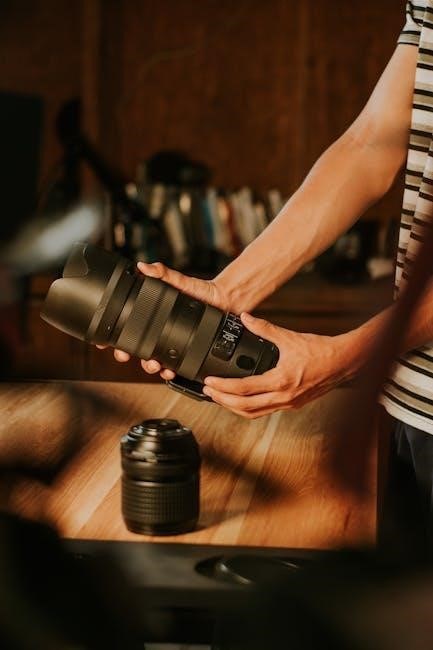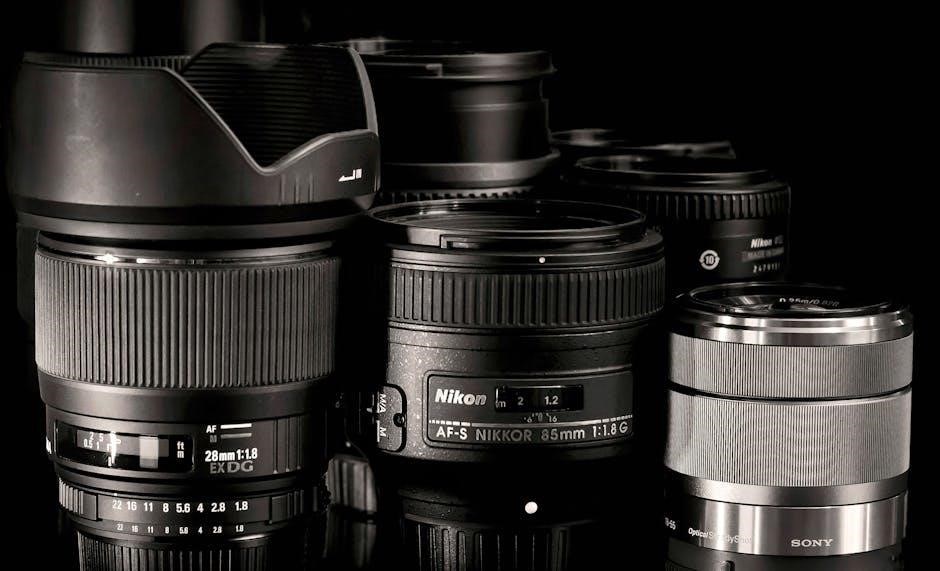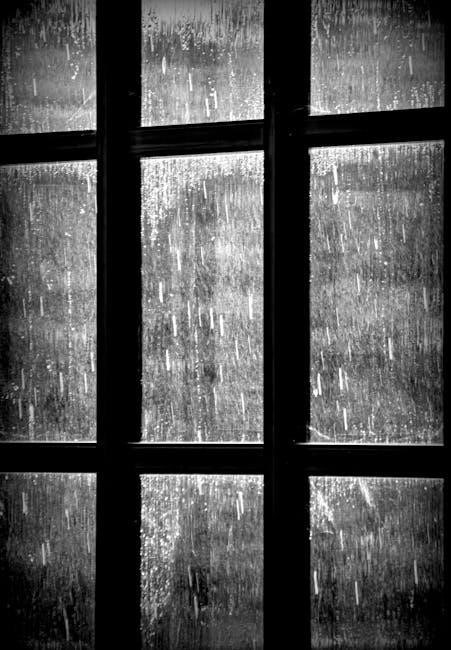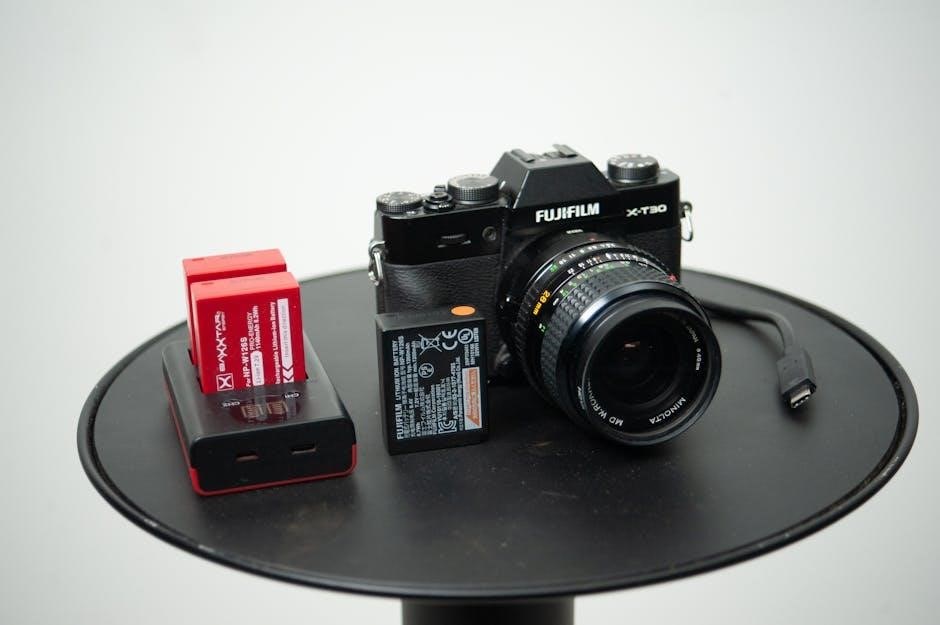The Nikon D7100 is a 24.71-megapixel APS-C DSLR designed for enthusiasts and professionals. Featuring a weather-sealed body, it offers a 51-point AF system, manual controls, and compatibility with DX lenses, enhancing creative photography experiences.
1.1 Overview of the Nikon D7100 Features
The Nikon D7100 is a high-performance DSLR camera designed for enthusiasts and professionals. It features a 24.71-megapixel CMOS sensor without an optical low-pass filter, delivering sharp images. The camera offers a 51-point autofocus system for precise subject tracking, weather-sealed construction for durability, and compatibility with DX-format lenses. Advanced shooting modes include Manual, Aperture-Priority, and Shutter-Priority, providing creative control. The EXPEED 3 image processor ensures fast performance and noise reduction, while the 3.2-inch LCD monitor offers clear image preview and menu navigation.
1.2 Intended Audience and Usage Scenarios
The Nikon D7100 is ideal for photography enthusiasts and professionals seeking advanced control. It suits various scenarios, including weddings, sports, wildlife, and landscape photography. The camera’s weather-sealed body and robust autofocus system make it suitable for outdoor and challenging conditions. Amateur photographers transitioning to DSLRs will appreciate its intuitive controls, while professionals will value its high image quality and customization options. The D7100 is also great for studio work, offering compatibility with external flash units and high-resolution output for detailed prints.

Key Components of the Nikon D7100
The Nikon D7100 features a 24.71-megapixel CMOS sensor, 51-point autofocus system, dual SD card slots, and weather-sealed construction, making it a robust tool for high-quality photography.
2.1 Buttons, Switches, and Dials
The Nikon D7100 features an intuitive array of buttons, switches, and dials designed for quick access to key functions. The mode dial on top allows selection of shooting modes like Auto, P, S, A, and M. The release mode dial, combined with the AF-mode button, enables easy switching between autofocus modes. The main command dial and sub-command dial provide precise control over aperture, shutter speed, and exposure compensation. Additional buttons like the ISO button and white balance button are strategically placed for easy access, ensuring seamless operation during shooting sessions.
2.2 Terminals and Connectivity Options
The Nikon D7100 offers a range of terminals and connectivity options for enhanced functionality. It includes a USB port for transferring images to a computer, an HDMI output for connecting to HDTVs, and a headphone jack for monitoring audio during video recording. Additionally, the camera features a dedicated accessory terminal for optional wireless adapters, enabling Wi-Fi connectivity. The built-in GPS unit allows for geotagging images, while compatibility with Nikon’s wireless remote controllers provides added convenience for remote shooting. These options ensure seamless integration with external devices and expand the camera’s versatility for various photography needs.
2.3 Viewfinder and Monitor Features
The Nikon D7100 features an optical pentaprism viewfinder with 100% frame coverage and 0.94x magnification, providing an accurate and immersive shooting experience. The 3.2-inch LCD monitor offers a high-resolution display with 1,228,800 dots, allowing for crisp playback and menu navigation. The monitor supports RGBW alignment for improved visibility in bright conditions. Additionally, the viewfinder display can be customized to show essential shooting information, while the monitor offers live view mode for precise composition and focusing. These features ensure precise control and enhanced visual feedback for photographers.

Shooting Modes
The Nikon D7100 offers multiple shooting modes, including Auto, Programmed Auto, Shutter-Priority, Aperture-Priority, Manual, and Scene modes, catering to both beginners and advanced photographers for diverse shooting scenarios.
3.1 Auto Mode
In Auto Mode, the Nikon D7100 simplifies photography by automatically adjusting settings like aperture, shutter speed, and ISO for point-and-shoot convenience. Ideal for beginners, this mode ensures well-balanced exposures with minimal user input. The camera optimizes settings based on detected lighting conditions, enabling quick and easy capture of moments. While it limits manual control, Auto Mode is perfect for those learning photography or needing fast, reliable results without adjusting advanced parameters. It’s accessed via the mode dial, offering a hassle-free experience for capturing sharp, vibrant images effortlessly.
3.2 Programmed Auto Mode (P)
Programmed Auto Mode (P) on the Nikon D7100 offers a balance between ease of use and creative control. The camera automatically sets aperture and shutter speed, but users can adjust ISO, white balance, and other settings to refine their shots. This mode is ideal for photographers who want to explore beyond full auto while still relying on the camera for exposure calculations. It’s accessed via the mode dial and is a great stepping stone for enthusiasts transitioning to manual modes, providing flexibility without the complexity of full manual control.
3.3 Shutter-Priority Auto Mode (S)
In Shutter-Priority Auto Mode (S), you control the shutter speed while the camera automatically adjusts the aperture for optimal exposure. This mode is ideal for capturing motion effects, such as freezing action or creating blur. The D7100 allows shutter speeds from 1/8000 to 30 seconds, offering flexibility for various lighting conditions. Exposure compensation is available to fine-tune results. The camera’s 51-point AF system ensures precise focus, making it suitable for sports or low-light photography. This mode balances creative control with automation, providing a practical option for photographers seeking to experiment with motion and lighting effects without manual mode complexity.
3.4 Aperture-Priority Auto Mode (A)
In Aperture-Priority Auto Mode (A), you set the aperture, and the camera automatically adjusts the shutter speed for proper exposure. This mode is ideal for controlling depth of field, allowing you to isolate subjects or ensure sharpness across the entire frame. The D7100 offers a wide aperture range, and its advanced light meter ensures accurate shutter speed selection. Exposure compensation is available to refine results. With precise control over depth of field and the camera’s 51-point AF system, this mode is perfect for portraits, landscapes, and creative photography, offering a balance of control and automation.
3.5 Manual Mode (M)
In Manual Mode (M), you gain full control over both aperture and shutter speed, allowing precise adjustments to achieve your desired photographic results. This mode is ideal for experienced photographers who want complete creative control. The D7100’s intuitive controls make it easy to adjust settings, and the LCD monitor provides clear feedback. With Manual Mode, you can experiment with unique effects, such as intentional overexposure or underexposure, and leverage the camera’s 51-point AF system for sharp focus. This mode requires a solid understanding of exposure principles but offers unparalleled flexibility for capturing artistic visions.
3.6 Scene Modes
Scene Modes on the Nikon D7100 simplify photography by optimizing camera settings for specific situations. Options include Portrait (for soft, natural skin tones), Landscape (vivid colors and sharp details), Sports (fast shutter speeds to freeze motion), and Night Portrait (balanced flash and ambient light). These modes automatically adjust aperture, shutter speed, and ISO for ideal results. Scene Modes are accessed via the mode dial, making it easy to adapt to various conditions without manual adjustments. They are perfect for beginners or quick shooting scenarios, offering convenience while maintaining high image quality.
Autofocus System
The Nikon D7100 features a 51-point autofocus system for precise subject tracking. It offers fast, accurate focusing in various lighting conditions, with advanced modes like 3D Tracking for dynamic subjects.
4;1 Autofocus Modes (Single AF, Continuous AF, Manual Focus)
The Nikon D7100 offers three autofocus modes: Single AF, Continuous AF, and Manual Focus. Single AF (AF-S) is ideal for stationary subjects, focusing quickly and precisely. Continuous AF (AF-C) is designed for moving subjects, adjusting focus continuously to maintain sharpness. Manual Focus (MF) allows photographers to fine-tune focus using the lens ring, enabling precise control. These modes, combined with the camera’s 51-point autofocus system, provide versatility and accuracy for various shooting scenarios, ensuring optimal results in both stills and dynamic compositions.
4.2 Autofocus Area Modes (Single Point, Dynamic Area, 3D Tracking)
The Nikon D7100 features three autofocus area modes: Single Point, Dynamic Area, and 3D Tracking. Single Point AF focuses on a selected point, ideal for stationary subjects. Dynamic Area AF uses a group of points to track moving subjects, offering more flexibility. 3D Tracking AF uses color and subject recognition to follow subjects across the frame, excelling in complex compositions. These modes, combined with the 51-point AF system, ensure precise and adaptable focus control, catering to diverse photography needs and enhancing overall shooting efficiency.

White Balance and ISO Settings
The Nikon D7100 offers customizable white balance settings, including Auto, Daylight, Fluorescent, and Cloudy modes, ensuring accurate color reproduction. ISO sensitivity ranges from 100 to 6400, extendable to 25600, balancing low-light performance and noise reduction for optimal image quality.
5.1 White Balance Options and Customization
The Nikon D7100 offers an advanced white balance system with multiple preset modes, including Auto, Daylight, Fluorescent, Incandescent, Flash, and Cloudy, ensuring accurate color reproduction in various lighting conditions. Additionally, users can customize white balance by setting a specific color temperature (2500K–10,000K) or using the PRE (Preset Manual) option, which allows capturing a reference image of a neutral object (e.g., a gray card) to create a custom white balance profile. This feature is particularly useful for achieving consistent colors in challenging lighting environments or for creative control over the image’s color tone.
5.2 ISO Sensitivity and Noise Reduction
The Nikon D7100 features an ISO sensitivity range of 100 to 6400, expandable to Hi-2 (equivalent to ISO 25600), enabling shooting in low-light conditions while maintaining image quality. The camera includes High ISO Noise Reduction, which can be set to Low, Normal, or High to minimize grain in high-sensitivity images. Additionally, Long Exposure Noise Reduction helps reduce noise in exposures longer than 1 second. These features work together to ensure crisp, detailed photos even in challenging lighting environments, providing photographers with flexibility and control over noise levels.

Viewfinder and Monitor
The Nikon D7100 features a high-quality optical viewfinder with 100% frame coverage and a 3.2-inch, 1,228,800-dot rear LCD monitor for precise image preview and review.
6.1 Customizing the Viewfinder Display
The Nikon D7100 allows users to customize the viewfinder display to suit their needs. Through the camera’s menu system, photographers can enable or disable various shooting information displays, such as exposure settings, metering modes, and focus points. This feature ensures a clutter-free viewfinder for distraction-free shooting. Additionally, the viewfinder’s grid display can be activated to aid in composition. Customizing these settings enhances the shooting experience, allowing users to focus on their subjects while maintaining quick access to essential camera data. The high-quality optical viewfinder provides 100% frame coverage, ensuring precise framing and accurate results.
6.2 Using the Rear LCD Monitor
The Nikon D7100 features a 3.2-inch, 1,228,800-dot rear LCD monitor for precise image review and menu navigation. The monitor allows for bright, clear playback of captured images, with options to zoom in for detail inspection.Brightness can be adjusted to suit lighting conditions. The LCD also supports live view shooting, enabling precise composition and focus control. Additionally, the monitor displays key shooting information and menu settings, making it easy to adjust camera parameters on the fly. This versatile display enhances both shooting and post-capture review workflows, providing a comprehensive tool for photographers.

Image Quality and File Formats
The Nikon D7100 delivers exceptional image quality with its 24;71-megapixel CMOS sensor. It supports NEF (RAW) and JPEG formats, offering flexibility in post-processing. The camera also features configurable color spaces, including sRGB and Adobe RGB, to match creative needs.
7.1 Image Resolution and Compression Settings
The Nikon D7100 offers multiple image resolution settings, including 6000×4000, 3936×2624, and 2896×1944 pixels, allowing photographers to choose the optimal size for their needs. JPEG compression settings are adjustable, with options for fine, normal, or basic quality, enabling users to balance file size and image quality. The camera also supports NEF (RAW) format, which captures uncompressed image data for maximum post-processing flexibility. These settings ensure versatility for both professional and enthusiast photographers, catering to various workflows and creative requirements.
7.2 NEF (RAW) and JPEG File Formats
The Nikon D7100 supports both NEF (RAW) and JPEG file formats, catering to different photographic needs. NEF files store uncompressed image data, preserving maximum detail for advanced post-processing. JPEG files, compressed for smaller file sizes, are ideal for sharing and immediate use. Photographers can choose to capture images in NEF, JPEG, or both formats simultaneously, offering flexibility in workflow. The D7100 allows customization of JPEG compression settings, while NEF files provide unparalleled quality for professional editing, making it a versatile tool for enthusiasts and professionals alike.
7.3 Color Space Options (sRGB, Adobe RGB)
The Nikon D7100 offers two color space options: sRGB and Adobe RGB. sRGB is ideal for web and social media use, providing vibrant colors and wide compatibility. Adobe RGB, with its broader color gamut, is suited for professional photography and advanced printing. Users can select the color space that best matches their workflow needs, ensuring accurate color representation. This feature allows photographers to maintain consistency and quality across different mediums, whether sharing online or producing high-quality prints.

Exposure Compensation and Bracketing
The Nikon D7100 allows adjustments to exposure compensation, enabling ±5 EV changes. Auto Bracketing captures multiple shots at varying exposures, enhancing dynamic range in challenging lighting conditions.
8.1 Exposure Compensation
The Nikon D7100 allows for precise exposure adjustments using Exposure Compensation. This feature enables users to adjust the brightness of images by ±5 EV in 1/3 EV increments. Accessible via the +/- button and the main command dial, it’s ideal for correcting exposure in challenging lighting conditions. Exposure compensation is applied in P, S, A, and M modes, though in Manual mode, it doesn’t affect the set aperture or shutter speed. Resetting compensation to default can be done by pressing the +/- button and the main command dial simultaneously, ensuring quick adjustments for optimal results.
8.2 Auto Bracketing (AEB)
Auto Bracketing (AEB) on the Nikon D7100 allows capturing multiple shots at varying exposure levels, ideal for HDR photography. Accessed via the Shooting Menu, AEB can be set in 1/3 or 1/2 EV increments, up to ±2 EV. Users can select 2, 3, or 5 shots, with the camera adjusting exposure automatically. After bracketing, settings reset to default, ensuring easy return to standard shooting. This feature enhances dynamic range in high-contrast scenes, providing flexibility in post-processing.

Flash and External Lighting
The Nikon D7100 features a built-in flash for fill lighting and supports external Speedlight units via hot shoe or wireless connection, allowing manual adjustment for creative lighting control.
9.1 Built-in Flash and Flash Modes
The Nikon D7100 features a built-in pop-up flash, ideal for fill lighting in low-light conditions. It offers multiple flash modes, including Auto, Red-Eye Reduction, Slow Sync, and Rear-Curtain Sync, providing flexibility for various lighting scenarios. The flash has a guide number of 12/39 (m/ft) at ISO 100 and covers a 24mm wide-angle lens. Users can also adjust flash compensation to fine-tune lighting output.
The built-in flash can be manually activated or set to fire automatically based on scene conditions. Additionally, it supports advanced wireless flash control when paired with external Speedlight units, enabling creative off-camera lighting setups for professional results.
9.2 Using External Flash Units
The Nikon D7100 supports external flash units, offering enhanced lighting control and versatility. Compatible with Nikon Speedlight flashes, such as the SB-400 and SB-700, these units provide advanced features like wireless operation and TTL metering. The camera can act as a commander in wireless flash setups, allowing multiple Speedlights to be triggered remotely. Users can choose from various flash modes, including i-TTL, Manual, and Repeating flash.
External flashes can be mounted on the hot shoe or connected via a sync cable. This setup enables precise control over lighting conditions, ideal for studio and portrait photography. For optimal results, consult the Speedlight manual for configuration details.

File Management and Transfer
The Nikon D7100 allows efficient file management and transfer. Users can delete unwanted photos using the O (Q) button and transfer images to a computer via USB or Wi-Fi. The camera also supports organizing files in folders and using Nikon software for seamless transfer and editing.
10.1 Deleting Unwanted Photographs
To delete unwanted photographs on the Nikon D7100, press the O (Q) button while the image is displayed on the monitor. This feature allows quick removal of individual photos. For multiple deletions, use the camera’s menu to select and delete specific images. The camera also supports deleting photos from a selected folder or all files, providing flexible file management options. Ensure to confirm deletion prompts to avoid accidental loss of data. This function is accessible via the playback menu, making it easy to organize your photos efficiently during or after shooting sessions.
10.2 Transferring Images to a Computer
To transfer images from the Nikon D7100 to a computer, connect the camera using the provided USB cable. Use Nikon Transfer 2 software for a seamless transfer, allowing you to select specific images or import all photos. Alternatively, insert the memory card into a card reader or use wireless transfer via Wi-Fi with compatible adapters. Ensure the camera is in “Mass Storage” or “PTP” mode for proper recognition. The software enables image organization and backup, making it easy to manage your photos efficiently after transfer.

Troubleshooting and Maintenance
Regularly clean the sensor and viewfinder to maintain image quality. Check for firmware updates to resolve common issues. Refer to the manual for error message solutions and maintenance tips.
11.1 Common Issues and Error Messages
Common issues with the Nikon D7100 include memory card errors like “CARD NOT FORMAT” or “NO MEMORY CARD.” Error messages such as “ERR” indicate camera malfunctions. Lens communication errors, like “F–,” occur when the camera cannot communicate with the lens. To resolve these, clean the lens contacts or reattach the lens. If the camera freezes, perform a hard reset by holding the shutter release and power button. Always refer to the manual for specific solutions or update firmware to address bugs. Persistent issues may require professional servicing.
11.2 Cleaning and Maintaining the Camera
Regular maintenance ensures optimal performance of the Nikon D7100. Use a soft, dry cloth to clean the camera body and lens surfaces. Avoid liquid cleaners, as they may damage coatings. For the image sensor, use a blower to remove dust. Turn off the camera, remove the lens, and gently blow air across the sensor. For stubborn spots, use a cleaning swab lightly dampened with sensor cleaning solution. Always handle the camera by the edges to prevent smudging the LCD or viewfinder. Store the camera in a dry, cool place to prevent moisture and humidity damage.
